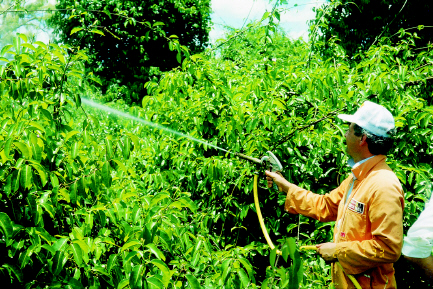|

Chemical control of rubber vine (Photo
courtesy of Queensland
Government,
Department of Natural
Resources and Mines).
|
The use of chemicals for weed control offers the greatest possibilities for relieving the physical effort which, in the past, has been necessary for this tedious chore. Chemicals function on the basis that certain
chemicals are capable of killing plants and that they kill some kinds of plants without significant injury to others. As a group, these phytotoxic chemicals are called
'Herbicides'. The use of chemicals for weed control has been practiced largely since 1944 following the discovery of the phytotoxic phenoxy group of chemicals. Today there are more than 180 different chemicals available for use as herbicides. They offer an almost bewildering array of trademark products of which there are thousands each varying from the other as to the active ingredients, concentration and/or formulation
of the constituents. Chemical control of weeds has paved the way to mechanisation and modern farm systems with large increases in productivity. As a result, today a farm worker
'feeds' 120 people worldwide compared with less than 20 in 1940.
Advantages of chemical weed control
Herbicides can be applied prior to the emergence of the crop, they can
permit closer crop row spacing, they lower labour involvement, they minimise
crop root damage, and they can be applied over a wide range of weather
conditions and at a very fast rate.
Disadvantages of chemical weed control
Herbicides are costly to produce and to apply (e.g. incorporation), and
they may provide inadequate levels of weed control or cause crop damage.
Herbicides need sophisticated equipment for application, they tend to
change weeds towards resistant types and may pollute soil, water and air
with their residues.
|

Aerial application of herbicide (Photo
courtesy of Queensland
Government,
Department of Natural
Resources and Mines).
|
Types of herbicides
Inorganic salts
This group has a long history but they have largely been replaced by modern organic herbicides. Sodium chlorate still remains a substantially used chemical for total weed control in non-cropping areas.
Organic herbicides
For an orderly study, organic herbicides may be grouped on the basis of one or more common characteristics such as chemistry, biological effect, application or use. Most text books group herbicides based on their chemical similarity. A number of chemicals will comprise a group or herbicide family. These families are listed below.
Phenoxy-carboxylic acids (e.g. MCPA, 2,4-D)
Substituted benzoic acids (e.g. Dicamba)
Picolinic acids (e.g. Picloram)
Benzonitriles (e.g. Bromoxynil)
Sulphonylureas (e.g. Chlorsulfuron)
Dinitroanilines (e.g. Trifluralin)
Carbamates (e.g. Propham, Asulam)
Bipyrazolum compounds (e.g. Difenzoquat)
Diphenyl ethers (e.g. Diclofop)
Substituted cyclohexanes (e.g. Sethoxydim)
Acid amides (e.g. Propanil)
Triazinones (e.g. Metribuzin)
Dintrophenols (e.g. Dinoseb)
Bipyridilium compounds (e.g. Paraquat)
Organophosphates (e.g. Glyphosate)
Imidazolinones (e.g. Imazaquin, Imazapyr)
Glufosinates (e.g. Glufosinate)
[ Back ] |

